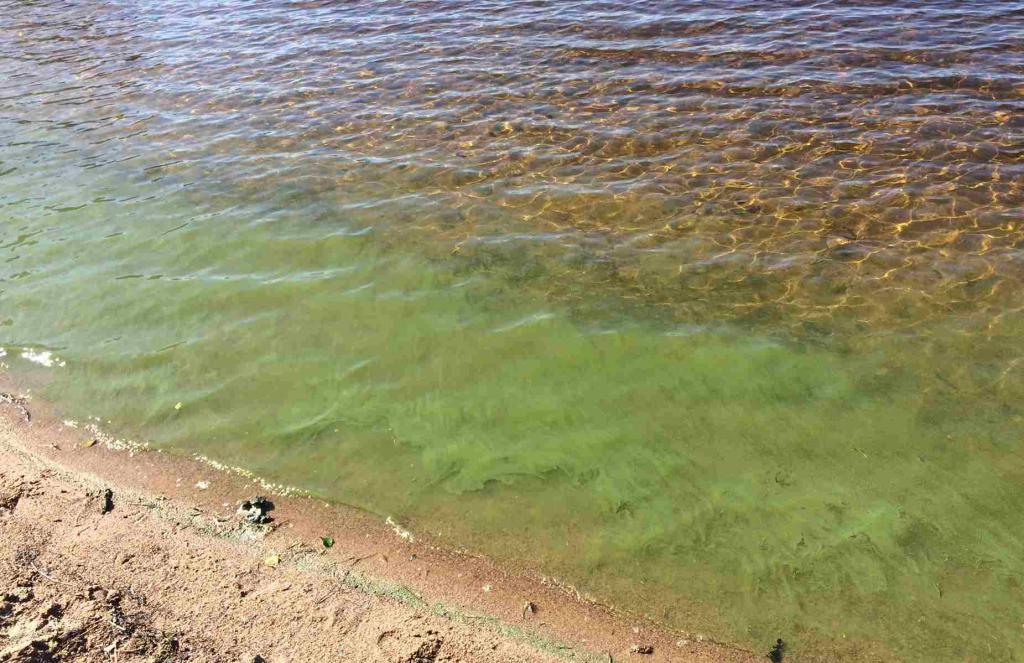Thessaloniki gets ready for its metro launch in November
The underground rapid transit lines have been under construction for almost two decades due to various project delays
 TheMayor.EU logo
TheMayor.EU logo 
Lappeenranta residents are called on to report sightings of blue-green algae blooming, Source: Lappeenranta Municipality
Where digitization and government resources cannot reach, citizens’ own responsibility is highly appreciated
Finland beckons the visitors in summer with its verdant greens and endless possibilities for getting intimately acquainted with Nordic nature. However, there are hazards there, too. One such is the so-called blue-green algae infestation, which occasionally invades the country’s lakes.
These microorganisms, formally known as cyanobacteria, can actually be quite toxic to humans, as they produce liver or nerve toxins, in addition to compounds that irritate the swimmer’s skin. Finland has its dedicated monitoring service for the presence of the algae, which is updated weekly. The problem is that, a cyanobacteria infestation can develop quite rapidly so the situation on the ground can be volatile and that cannot always be timely reflected on the portal.
The city of Lappeenranta, in South Karelia, has actually called on to its residents to show true civic dedication to public health and assist the administration by making their own reports when they spot a lake blooming with blue-green algae.
Residents can easily record their observations in the Havaintolähetti online portal, through which the the observations are then published in the national algae monitoring website. Another thing they can (and should do) is report the sightings to the health protection authority. The latter then posts the info on the bulletin boards of swimming beaches and on the websites of municipalities.
Lappeenranta lies on the shore of Lake Saimaa, which is the largest in Finland. But only saying that it’s the largest does not do it poetic justice. It also contains no less than 14,000 islands and has a total shoreline length of 15,000 kilometres! It’s a wonderful and natural watercourse labyrinth which can take ages to explore, but this is also what makes it hard to constantly monitor all the beaches for algae infestations.
Taina Rajala, the health inspector of the Lappeenranta region's environmental action, and Marcella Suomalainen, the environmental engineer of the Imatra region's environmental action, say that the municipal health protection authority that supervises public beaches does not visit the beaches every day to assess the presence of blue-green algae.
It is easy to understand how that would be a mammoth task and so the services do not report on the blue-green algae situation every day. The administrations, together with South Karelia’s Social and Health Care District (Eksote), have thus developed an information package for the residents on the identification and adverse effects of blue-green algae.
The social concern for public health also reminds us that while digital tools are important and helpful features, some things, such as awareness, knowledge, and even testing, should still rely on old-fashioned ways.
The administration has urged would-be swimmers to test the waters for blue-green algae with the following techniques.
The drinking glass test – fill a glass of lake water and let it stand for about an hour, during which time if there is a presence of microscopic blue-green algae they will rise to the surface. The algae do not always rise to the surface but can be visible in the water as tiny green particles.
The stick test is better if you already see accumulation of algae on the lake surface. With a wooden stick you try to lift the algae mass into the air. If the algal mass breaks down into small green particles in the water, rather than cling to the stick in long strands, the algae is blue-green algae.
Beaches, which are experiencing cyanobacteria infestation should be best avoided. Water from them is not recommended even for watering edible plants in the garden.

The underground rapid transit lines have been under construction for almost two decades due to various project delays

Now you can get your wine in Talence by paying directly in Bitcoin

That’s because the state has to spend money on updating the railway infrastructure rather than subsidizing the cost of the popular pass

Rethinking renewable energy sources for the urban landscape

The examples, compiled by Beyond Fossil Fuels, can inform and inspire communities and entrepreneurs that still feel trepidation at the prospect of energy transition

Now you can get your wine in Talence by paying directly in Bitcoin

The 10th European Conference on Sustainable Cities and Towns (ESCT) sets the stage for stronger cooperation between the EU, national and local level to fast track Europe's transition to climate neutrality.

At least, that’s the promise made by the mayor of Paris, Anne Hidalgo

The underground rapid transit lines have been under construction for almost two decades due to various project delays

At least, that’s the promise made by the mayor of Paris, Anne Hidalgo

Hostal de Pinós is located in the geographical centre of the autonomous region

Despite its church-y name, the district has long been known as the hangout spot for the artsy crowds

Urban dwellers across the EU are having a say in making their surroundings friendlier to people and the environment.

Forests in the EU can help green the European construction industry and bolster a continent-wide push for architectural improvements.

Apply by 10 November and do your part for the transformation of European public spaces

An interview with the Mayor of a Polish city that seeks to reinvent itself

An interview with the newly elected ICLEI President and Mayor of Malmö

A conversation with the Mayor of Lisbon about the spirit and dimensions of innovation present in the Portuguese capital














